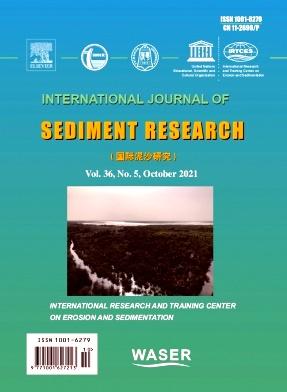Impact of different types of sediment-filled check dam systems on runoff erosion dynamics in a Loess Plateau watershed
IF 3.7
2区 环境科学与生态学
Q2 ENVIRONMENTAL SCIENCES
引用次数: 0
Abstract
Check dams, as one of the most representative soil and water conservation measures in the Loess Plateau region, primarily impact hydrological and hydrodynamic processes by regulating flows of water and sediment. Constrained by reservoir capacity, sediment accumulation within check dam systems affects their ability to intercept water and sediment. However, there has been limited research on the regulatory role of sediment-filled check dams on watershed hydrodynamics. This study focused on small watersheds in loess hilly gully areas and applied the MIKE SHE model to simulate hydrodynamic processes under different scenarios of filled check dam systems. The regulatory effect of different filled check dam system types on watershed hydrodynamics in the study area was analyzed. The results indicate that after sedimentation in various types of check dams, the peak flow can be reduced by 59.68%–68.66%, the flood duration can be extended by 42.74%–375.81%, and the runoff erosion power can be reduced by 62.92%–85.35%. The reduction in flood volume diminishes with increasing sedimentation, reaching a minimum of 2.42%. Moreover, there are varying degrees of reduction in runoff erosion dynamics in the main channels. These findings provide theoretical support for identifying the regulatory potential of sediment-filled check dam systems on hydrodynamic processes in small watersheds.
黄土高原不同类型填沙淤积坝对流域径流侵蚀动力学的影响
拦坝是黄土高原地区最具代表性的水土保持措施之一,其主要作用是调节水沙流量,影响水文动力过程。受水库容量的制约,止沙坝系统内的泥沙淤积影响其截水截沙能力。然而,关于填沙淤积坝对流域水动力的调节作用的研究还比较有限。本文以黄土丘陵沟壑区小流域为研究对象,应用MIKE SHE模型模拟了不同淤地坝体系情景下的水动力过程。分析了研究区不同填筑挡土坝体系类型对流域水动力的调节作用。结果表明:各类型淤积坝淤积后,洪峰流量可降低59.68% ~ 68.66%,洪期可延长42.74% ~ 375.81%,径流侵蚀功率可降低62.92% ~ 85.35%;随着泥沙淤积的增加,洪量减小幅度逐渐减小,最小可达2.42%。此外,主河道的径流侵蚀动态也有不同程度的减少。这些发现为确定填沙止回坝系统对小流域水动力过程的调节潜力提供了理论支持。
本文章由计算机程序翻译,如有差异,请以英文原文为准。
求助全文
约1分钟内获得全文
求助全文
来源期刊
CiteScore
6.90
自引率
5.60%
发文量
88
审稿时长
74 days
期刊介绍:
International Journal of Sediment Research, the Official Journal of The International Research and Training Center on Erosion and Sedimentation and The World Association for Sedimentation and Erosion Research, publishes scientific and technical papers on all aspects of erosion and sedimentation interpreted in its widest sense.
The subject matter is to include not only the mechanics of sediment transport and fluvial processes, but also what is related to geography, geomorphology, soil erosion, watershed management, sedimentology, environmental and ecological impacts of sedimentation, social and economical effects of sedimentation and its assessment, etc. Special attention is paid to engineering problems related to sedimentation and erosion.

 求助内容:
求助内容: 应助结果提醒方式:
应助结果提醒方式:


